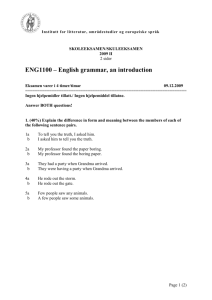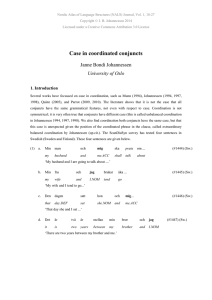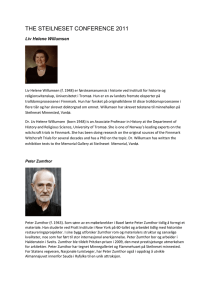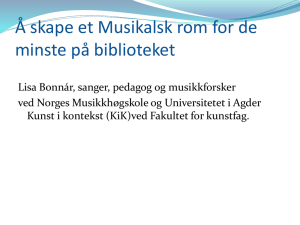-84- COMBINATORY COORDINATION IN NORWEGIAN Svein Lie Institutt for nordisk språk og litteratur
advertisement
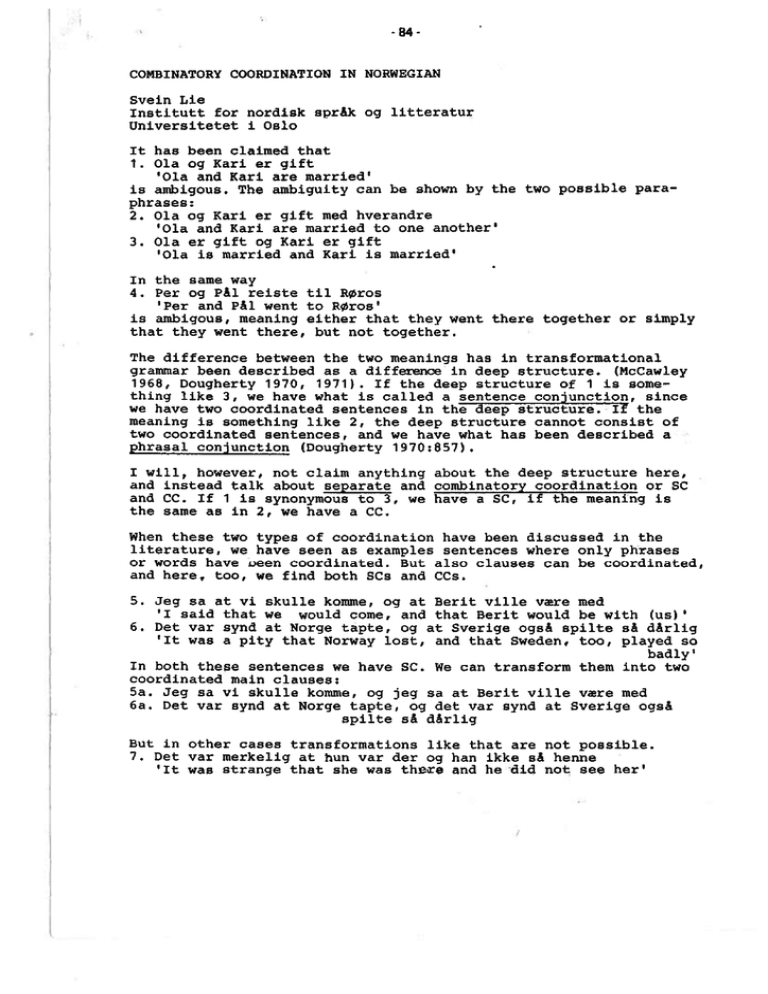
-84COMBINATORY COORDINATION IN NORWEGIAN Svein Lie Institutt for nordisk språk og litteratur Universitetet i Oslo It has been claimed that 1. Ola og Kan er gift ‘Ola and Kan are married’ is ambigous. The ambiguity can be shown by the two possible para phrases: 2. Ola og Kan er gift med hverandre ‘Ola and Kan are marnied to one another’ 3. Ola er gift og Kan er gift ‘Ola is marnied and Kan is marnied’ In the same way 4. Per og Pål reiste til Røros ‘Per and Pål went to Røros’ is ambigous, meaning either that they went there together or simply that they went there, but not together. The difference between the two meanings has in transformational grammar been descnibed as a differenoe in deep structure. (McCawley 1968, Doughenty 1970, 1971). If the deep structure of 1 is some thing like 3, we have what is called a sentence conjunction, since we have two coordinated sentences in the deep structure. If the meaning is something like 2, the deep structure cannot consist of two 000rdinated sentences, and we have what has been descnibed a phrasal conjunction (Dougherty 1970:857). I will, however, not claim anything about the deep structure here, and instead talk about separate and combinatory coordination or SC and CC. If 1 is synonymous to 3, we have a SC, if the meaning is the same as in 2, we have a CC. When these two types of coordination have been discussed in the literature, we have seen as examples sentences where only phrases on words have veen coordinated. But also clauses can be coondinated, and here, too, we find both SCs and CCs. 5. Jeg sa at vi skulle komme, og at Berit ville være med ‘I said that we would come, and that Berit would be with (us)’ 6. Det var synd at Norge tapte, og at Sverige også spilte så dårlig ‘It was a pity that Norway lost, and that Sweden, too, played sa badly’ In both these sentences we have SC. We can transform them into two coordinated main clauses: Sa. Jeg sa vi skulle komme, og jeg sa at Berit ville være med 6a. Det var synd at Norge tapte, og det var synd at Sverige også spilte så dårlig But in othen cases transformations like that are not possible. 7. Det var merkelig at hun var der og han ikke så henne ‘It was strange that she was theae and he 8i4 not see her’ - 85 - 7a. Det var merkelig at hun var der, og det var merkelig at han ikke så henne ‘It was strange that she was there, and it was strange that he did not see her’ 7a. is a possible Norwegian sentence, but not synonymous with 7 (in the preferred reading). The meaning of 7 is not that it was strange by itself that she was there, neither that he did not see her (if she was not there, it would not have been strange). What is strange is rather that he did not see her, taken inte consideration that she was there. Informally speaking, we could say that it is the co— ordinating itself that is strange. That means that in 7 we have an example of CC. So far semantics. But this semantic difference may be formally ex— pressed, e.g. by the presence er absence of the complementizer or conjunction at (that). It has been claimed (Western 1921:244) that when two at—clauses are coordinated, at is obligatory in the last one. That is only oartly correet. It is true when we have SC: 6b. ?Det var synd at Norge tapte, og Sverige også spilte så dårlig But in CCs the deletion of at is possible and even preferable: 7.Det var merkelig at hun var der og han ikke så henne This means that we may have pairs of s’entences with and without at where the meaning is different. 8. Det var rart at Inger var der og at Knut holdt seg hjemme ‘It was funny that I. was there and K. stayed at home’ Ba. Det var rart at Inger var der og Knut holdt seg hjemme In my view Ba means that it was funny that Knut was not there con— sidering the fact that Inge~r was there, or that she was there in— stead of Knut. 8 may have the same meaning, but also that the facts expressed in both at—clauses are funny. 9. Det var rart at Petter stod og at du strøk ‘It was funny that P. passed (the exam) and that you failed’ 9a. Det var rart at Petter stod og du strøk What is meant in 9 may be that two different facts are funny, in 9a on the other hand, that it is funny that you failed when Petter passed. The difference between such pairs of clauses may also be formally expressed in another way. If the coordinated clauses follow a negated verb in the matrix clause, we may get the disjunctive con— junction eller (or) instead of ~ if we have a SC: 10. Jeg tror ikke at Petter stod eller at du strøk ‘I don’t believe that P. passed or that you failed If we have a CC, eller is not possible: lOa. Jeg tror ikke at Petter stod og du strøk 10 b. ??Jeg gror ikke at Petter stod eller du strøk *** We have now seen that when the complementizer is absent, we have a CC. If we then follow newer variants of transformational grammar, saying that sentences and clauses including complementizers are not simply Ss, but Ss, we could say that in the type of sentences we have discussed so far, CCs seem to be coordjnations of Ss, while -86SCsare coordinations of §s. This means that the structure of 9 is -- - S — I at Conj — S — s cor~ Petter stod I og at — s __ du strøk while the strueture of 9a is (9a) 5 00141’ — — 3 at s Conj I Petter stod og 3 ZN du strøk Because the semantie interpretation o~ these constructions is dic_ ferent, there can be no simple transformation like Complementizer Deletion (or free deletion in COMP as proposed by Chomsky and Lasnik 1977). Even if the rules proposed are adjusted so they will allow structures without any complementizer on the second conjunôt, they will make wrong predictions since they will claim that the deletion does not change the meaning, which is not correct. ** * So far we have discussed examples where both conjuncts have been complete clauses. But the facts discussed above seem to be inter— related in an interesting way with deletion rules like Gapping or Conjunction Reduction (CR). It has been mentioned by Jackendoff (1977:45) that Gapping operates on the conjunction of Ss, not Ss, since the COMP cannot be present in the second conjunct in such cases. This is true also for Norwegian. 11. Han sa at Marit skulle til Bergen og Berit til Trondheim ‘He said that M. Was going to B. and B. to T.’ ila. ~‘Han sa at Marit skulle til Bergen og at Berit til Trondheim (In such cases where Gapping is possible, at is only partly p05sible even when the second conjunct is a full clause, which further corrobates the hypothesis that Gapping is derived f rom a conjunction of Ss.) But that would also mean that in cases where it is relevant to dis tinguish between SCs and CCs, Gapping will take place only where we have CCs. If we bok at the pair ..of sentences 12. Det var rart at Petter fikk laud og at du bare fikk haud -87‘It was funny that P. got laud and that you only got haud’ 12a. Det var rart at Petter fikk laud og du bare fikk haud the difference may be described in the same way as the difference between 9 and 9a. If Gapping takes place here, however, the meaning seems to me to be the same as in 12a, i.e. a CC. 12b. Det var rart at Petter fikk laud og du bare haud Williams (1978) claims that the domain of CR can only be Ss, not Ss. This seems to be confirmed by the Norwegian data. In a sentence like 13. Hun sa de hadde kjøpt ny bil og skulle reise på ferie dagen etter ‘She said they had bought a new car and were going on vacation the next day’ Conjunction Reduction has taken place because we have a CC. In other words the semantic content of the two clauses is looked upon as one complex fact. In a sentence where such an interpretation is less natural, CR cannot take place even if the formal conditions are met: 14. Hun sa at de hadde kjøpt nytt hus, og at de skulle reise på ferie dagen etter She said that they had bought a new house and were going on vacation the next day’ 14a. ??Hun sa at de hadde kjøpt nytt hus og skulle reise på ferie dagen etter In 15. Det var rart at Inger var der og ikke Knut ‘It was strange that I. was there and f~ot K.’ the VP has been deleted in the second conjunct, and the conjunction is unambigously of the CC type, which means that the sentence is roughly synonymous to Sa. So far we have been looking only at clauses with (or without) the complementizer at (that). But the pattern outlined above seems also to hold for other kinds bf clauses. 16. De spurte om jeg hadde tatt eksamen og om jeg skulle jobbe i ferien ‘They asked whether I had passed the exam and whether I was going to work during my holidays’ 16a. ??De spurte om jeg hadde tatt eksamen og skulle jobbe i ferien Two different faots are asked for, and CR cannot take place. 17. De spurte om jeg hadde tatt eksamen og skulle begynne å jobbe ‘They asked whether I had passed the exam and was going to start working’ flere the exam and the work are seen in connection with one another, and CR takes place. Support for what I have claimed above can also be drawn f rom clauses with a wh—complementizer. 18. Jeg spurte hvem som var gift og hvem som var lykkelig ‘I asked who was married and who was happy’ 18a. Jeg spurte hvem som var gift og lykkelig - 88 - The structure in 18 cannot be the direct source of 18a because they have different meanings. In 18 hvem varies over sets that are not necessarily the same. In 18a, on the other hand, the sets of married people and happy people must be identical. The analysis of these constructions has been disputed. But 18 is undoubtedly a coordination of Ss, with hvem or som or both in COMP position. If som is in COMP position, it would account for the fact that Gap ping is not possible with som left after a wh-word. If hvem is in COMP position, it would account for the low acceptability of 19b, but here my informants differ in their judgment, and the analysis is unclear. 19. Jeg spurte hvem som skullekjøpe vin og hvem som skulle kjøpe ost ‘I asked who (that) should buy wine and who (that) should buy cheese’ 19a. *Jeg spurte hvem som skulle kjøpe vin og hvem som ost 19b. ??Jeg spurte hvem som skulle kjøpe vin og hvem ost As for semantics here, in the preferred reading of the 19 the referents of the two instances of hvem are not the same. In a sen— tence like 19c. Jeg spurte hvem som skulle kjøpe vin og ost where CR has taken place, the person(s) going to buy wine and cheese must be the same. In the cases og 18a and 19b, however, it could be said that CR cannot take place because the referents of the two instances of hvem are not identical (although such a condition is very rarely mentioned when rules for CR are given) In the same way the difference between the two following sentences could be explained: 20. Jeg traff henne da hun studerte og da hun bodde her ‘I met her when she studied and when she lived here’ 20a. Jeg traff henne da hun studerte og bodde her In 20 da (when) refers to two different points of time, whereas in 20a the studying and the ‘living here’ must have been taking place at one and the same time. . Conclusion. We have in this paper investigated a subset of Norwegian sentences, and found out that coordinated clauses without any complementizer in the second conjunct may have differént semantic properties f rom corresponding coordinated elauses where the complementizer is pre— sent in the second conjunct. I have clairned that in the former case we have Combinatory Coordination (CC), in the latter Separate Co— ordination (SC). We have further found that in the set of sentences investigated here transformations like Conjunction Reduction, Gapping, and V?— Deletion are taking place only in the cases where we have CC. That means that transformations like these are subject to more subtle semantic conditions than it has been claimed till now. These facts also make the very existence of the transformations themselves dubious. suggesting that it would perhaps be a better analysis if all coordinated structures were base generated. * * * - 89 - Bibliography: Chomsky, N. & H.Lasnik (1977): Filters and Control, Linguistic Inguiry 8. Dougherty, R.C. (1970,1971): A Grammar of Coordinate Conjoined Structures I—II, Language 46, 47. Jackendoff, R. (1977) : X Syntax: A Study of Phrase Structure. MITPress, Cambridge. McCawley, J.D. (1968): The Role of Semantics in ~ Grammar. In E. Bach & R.T.Harms: Universals in Linguistic Theory. New York. Western, A. (1921): Norsk riksmålsgrammatikk. Kristiania. Williams, E. (1978): Across—the—Board—Rule Application. Linguistic Inguiry 9. I: Thorstein Fretbeim & Lars Helland (red.): Papersfrom the Sixth Scandinavian Conference of Linguistics. Trondheim 1982.
